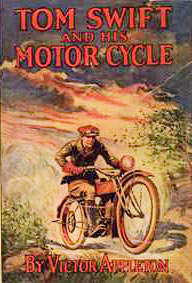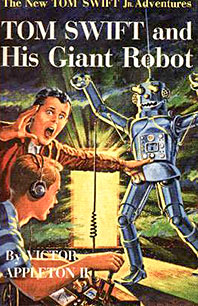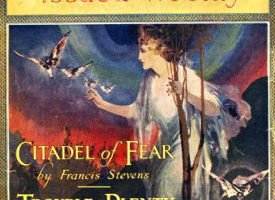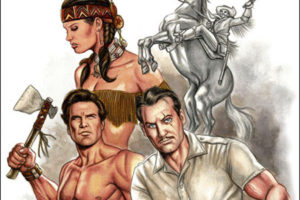
The main boy inventor/adventure juvenile series is that of Tom Swift. Of which there have been five series over the years, with at least two different Tom Swifts (depending on how you look at them). Created by the Stratemeyer Syndicate, it’s one of their more successful ones, but owing to the changes in science and technology, they basically had to relaunch the character rather then just do minor tweaks to the stories like their mystery series Hardy Boys and Nancy Drew.
As a boy, I got many of the Tom Swift Jr. books. They were in hardcover, with what is known as “picture covers,” where the artwork is incorporated into the cover rather than on a dust jacket. The spines were an orange/yellow, contrasting with the blue of the Hardy Boys and the yellow of Nancy Drew. I found the science a bit over the top, more fantastical than realistic, but enjoyed them, and have been working to complete my collection of them. I soon found out that my dad had read the original Tom Swift series, and have been trying to collect those stories, either original or reprints.
As noted, over the years there have been five Tom Swift series.
The first series launched in 1910 and ran for 38 volumes through 1935, then later two “Better Little Books” in 1938 and 1941, which aren’t proper novels, being half prose, half comic. They starred young inventor Tom Swift, son of Barton Swift who ran the Swift Construction Co. in Shopton, N.Y. His mother had passed away years prior. His main pal is Ned Newton, and he dated (and later married) Mary Nestor, in the series (so wasn’t a “boy inventor” for long).
Most of his inventions at first were not that amazing. A better motorcycle, a motor boat, but soon we would get airships, television detectors, electric rifles, and such.
As best we know, the novels were written by Howard Garis at first, but the last few were written by Harriet Stratemeyer Adams. All were published under the Syndicate housename of “Victor Appleton.”
In the ’50s they launched the next series, which is the classic Tom Swift Jr. series, for 33 volumes from 1954-71. Yes, the son of the first Tom Swift, who now runs Swift Enterprises in Shopton. Bud Barclay is his pal. He has a younger sister, Sandra, who is about his age (17), and a pilot. His usual date is Phyllis Newton, daughter of Ned Newton from the original series who is head of finance for the company. There are several other employees of the company around from the original series.
Here, while the science is supposed to be more accurate, apparently having the stories vetted by scientific experts, as I noted they are more fantastical than the original, what with spectromarine selectors, aquatomic trackers, triphibian atomicars, repelatron skyways, and the like. The contemporary Rick Brant series, also published by Grosset & Dunlap, had more realistic science adventures.

There were also a couple of background story elements that ran through the series. There were the mysterious “Space Friends” from Planet X that Tom Jr. contacted. But that storyline was never fully resolved. And owing to the Cold War period, there were the two sinister Eastern European countries of Kranjovia and Brungaria that were trying to steal Tom’s inventions.
“Victor Appleton II” was the apparent author, but Harriet Stratemeyer Adams oversaw the series with 6 authors. Jim Lawrence wrote the bulk: #5-7, 9-29.
The books originally were hardback with dust jackets, like most juvenile series. In 1961, they went with picture covers (artwork incorporated into the covers themselves), first with blue spines, then switched to orange in 1962, and all books in the series would be reprinted in this style. This happened with all of G&D series, and other publishers followed. The last two or three volumes are hard to find (I’m still looking for those). I saw Tom Swift hardbacks for sale in bookstores into the 70s. Later, 4 would be reprinted in trade paperback and another 6 in mass-market paperback. An interesting update in the paperbacks is how Tom Jr. was depicted. In the original he had a blond crew cut, but in the newer editions, he had a more current, long hair look.
As noted in my previous posting, after the series ended, the Syndicate sold the rights to Tom Swift to Simon & Schuster. They would go on an create three more series with other packagers.
The next Tom Swift series came in the ’80s, with 11 volumes from 1981-84, plus two unpublished stories. It was hard to figure out if this was Tom Swift III or just Junior revamped. He was the son of the “great Tom Swift,” but which one? Swift Enterprises was now in New Mexico, but the series was mainly set in space. Tom now had two other associates: Benjamin Franklin Walking Eagle, his best friend, and former rival now friend (but not girlfriend) Anita Thorwald. (Frankly this seemed to me an attempt at being inclusive and “P.C.”)
The ’90s brought us the fourth Tom Swift series, who is clearly Tom Swift Jr., son of Tom and Mary. This series is set on Earth, and Swift Enterprises is now in California (though I recall of hints that the original Swift Enterprises location in Shopton still exists, but is now used by the main bad guy of the series). A change is that Tom’s inventions can be dangerous and destructive. The series ran for 13 volumes in 1991-93, with two additional volumes having a team-up between Tom and the Hardy Boys.
And the 2000s brought us the fifth Tom Swift series, called “Tom Swift, Young Inventor.” Again, Tom Swift Jr., son of Tom and Mary. Swift Enterprises is back in Shopton, N.Y. Pals are Bud Barclay, but now adding Puerto Rican Yolanda “Yo” Aponte for diversity, as well as noting that both his mother and sister are scientists in their own right (something that was not so in the earlier series). This one lasted but six volumes in 2006-07, with an apparent unpublished seventh.
As noted, Tom Swift Jr. was a series I grew up on. I haven’t been too happy with the succeeding series, and they don’t seem to have been very successful. Grosset & Dunlap keep reprinting their Hardy Boys and Nancy Drew volumes. Wish someone would reprint the whole Tom Jr. series, but doubt it will happen. Just too dated in terms of technology. It is interesting that there are some creating NEW Tom Jr stories as an extension to the original one. But will we see an official sixth series? Who knows?




did you know the Taser is named after Tom Swift? the company gave him a middle initial to make = Tom A. Swift Electronic Rifle.. FYI and I’m surprised no one has made a live action movie or toon about him…
Apropos of nothing in particular, but remember those Tom Swiftie “jokes” that were popular in the 60s?
Like, “I might as well be dead,” Tom croaked.
And I never heard of them until I started to read about Tom Swift. I never came across them in the 60s. But I was a bit young.
Jack Cover, Orange County, California, inventor of the TASER borrowed the name from Tom Swift. Clearly he was looking for something akin to MASER, LASER or Phaser. Initially it had been called TSER.
Tom Swift of the series never had a middle name. That is fitting since Edward Stratemeyer and his daughter Harriet Stratemeyer did not have a middle name either. She used her maiden name as a middle name after her marriage in 1915.
In the 1911 story, Tom Swift’s Electric Rifle shot “wireless bullets of energy.” Clearly the TASER does not do this. It’s about like calling those things they have today “hoverboards.”
Instead, the details of the concept of the TASER, shooting barbed darts with trailing wires to carry the stunning current, was lifted from another Stratemeyer Syndicate science fiction story ghostwritten by Howard R. Garis. That story is in the Great Marvel series by “Roy Rockwood” as published by Cupples & Leon: Under the Ocean to the South Pole (1907).
If a vague description of “machine vision” can get a patent and “prior art” can deny a patent, what does it say to the validity of a patent based on an old book? For quotes from the corresponding books of interest, see this old presentation text of mine. The word still hasn’t gotten around, partly because of TASER International press releases that try to tie their product to Tom Swift and nothing else. Sometimes this brings negative publicity to an otherwise good series when a TASER causes injury or death because it is overused or misused.
http://keeline.com/articles/NAJVS-Electric_Rifle.pdf
Another legacy of Tom Swift that isn’t quite so is the “Tom Swifty” joke format. These were introduced around 1963 and have a piece of quoted dialogue followed by a speech identifier such as “said Tom” followed by an adverb that humorously refers back to the quote. These became a craze in the 1960s and were kept alive by frequent use on the “Think and Grin” page of Boys’ Life magazine for the Boy Scouts.
“Go to the back of the boat,” said Tom sternly.
The problem? The sentence structure attributed to the original Tom Swift books is actually very rare in it. Instead, what you do find are different verbs of speech to replace the overuse of the word “said.” Thus you may read that Tom “cried,” “murmured,” “exclaimed,” and numerous other words that tried to convey how Tom or another character was uttering their words. In the humor field, this is called a Croaker when the verb humorously refers to the quoted phrase.
Tom Swifties are great fun and once people are reminded of them, they tend to chip in their favorites, overtaking many a Tom Swift thread.
So many people associate these with the essence of Tom Swift that the Parker Bros. Tom Swift Jr. Board Game (1966) used them. Also some of the later ghostwriters of the most recent series used them but the editors quashed them before publication.
They are great fun but they are not what Tom Swift deserves to be remembered for.
There have been several unsuccessful attempts to put Tom Swift on the large or small screen.
The earliest goes back to Universal in 1914. This is the small company (then) that did the 1916 Twenty Thousand Leagues Under the Sea film with pioneering underwater photography. It was not done by them because they could not find a youthful actor for the lead who could also do the stunts required.
In the 1930s and 1940s there were several inquiries and efforts to make newspaper comic strips (think Buck Rogers), animated films (á la the Fleischer Superman), and radio serials (like Captain Midnight or Jack Armstrong). However, none of these were able to follow through. The Cardinal Company made two audition installments for a Tom Swift and His Atom Motor radio show from 1946.
In the mid- to late-1950s a Tom Swift Jr. TV show was attempted. A pilot called “The Solar Sub” was filmed with Gary Vinson as the lead. Herbert L. Strock and Barry M. Kirk were the producers. They tried to get a sponsor from the three networks of the day and the two cereal companies but failed to do so.
The biggest attempt was when Twentieth Century-Fox had the option in the mid- to late-1960s. They created two drafts of the script, two full-size airships of the 1910 variety, and had Frank McCarthy named as producer, Gene Kelly as director, Dale Hennesy as art director, and Michael Crawford as Tom Swift. Despite all of this, no filming was done. Reasons for not making it were numerous, including a wind storm damaging the airships, cost of the film, the decline of the “roadshow” release system, and failure to get the principals’ schedules in sync after delays. We have parts from this film attempt, including a vintage copy of the revised script, concept art, and the surviving pieces from the “Aeroships.”
After Fox released it, Levy-Gardner-Laven had two scripts written, one Tom Sr. and one Tom Jr. but neither went anywhere.
In 1983 a Tom Swift / Linda Craig Mystery Hour TV pilot with Willie Aames and Lori Loughlin in the lead roles was made and broadcast. It was not picked up. It was not similar to any of the books though. In the early 1980s the third Tom Swift series being published, at the same time that Linda Craig was being reprinted from the 1960s, was set in the far future to avoid NASA catching up with Tom’s inventions.
An episode of the Young Indiana Jones Chronicles (“Princeton, 1916”) has Tom Swift and Stratemeyer references though they generally get the details wrong. They tried to fix this a little with the DVD release by adding bonus features with a short bio of Stratemeyer. It has problems even though I spoke with the producers extensively during its creation. I didn’t get to see the script so they tripped in a number of rabbit holes of mythology.
About a decade ago there was talk of Worldwide Biggies (Albie Hecht) and Columbia (Barry Sonnenberg) doing something with Tom Swift. Some descriptions of the new Tom being focused on “green inventions” did not bode well. Hecht’s connections with Jimmy Neutron and A Series of Unfortunate Events was also a concern. It’s hard to say if this could be remedied with Barry’s Men in Black pedigree.
This article is old but I have already posted it online. A much updated presentation was made in 2010 when we hosted the 100th anniversary Tom Swift convention in San Diego.
http://keeline.com/articles/PCA1995-Tom_Swift_Silver_Screen.pdf
The five Tom Swift series are all different generations, despite any repetition of names.
The first two are closely linked with characters and inventions from the first in the second. However, the third series (1980s) was set in the far future because NASA had sent men to the Moon in a very different way than Tom Swift’s Challenger ship that looked like a flying gyroscope propelled by “Repelatrons.”
Early Tom Swift Jr. volumes were closer to scientific reality but once certain parts were added, they became farther and farther afield.
Grosset & Dunlap was already publishing the Rick Brant series (1947-1968) and though Tom Swift Jr. was proposed at the same time, it was delayed as the idea was reworked to make sure that it would not be too similar. Most of Rick Brant is good science except for the end of volume 1, The Rocket’s Shadow (1947) where they are debating whether it would take a rocket 60 or 90 seconds to reach the Moon.
The fourth series (1990s) tried to bring Tom Swift inventions back to what might be possible in science in the news with a little extrapolation — much the way the original series stories were inspired. Unfortunately, they were a little too influenced by Hollywood “inventions” such as a hovering surfboard and a shrink ray. The series lost some of its potential.
The fifth series (2000s) was a first-person attempt to bring it back. They couldn’t decide if Tom Swift was a kid doing high school robotics competitions (e.g. Robot Olympics) or the kind of adventure seen in the Tom Swift Jr. series (e.g. Into the Abyss). The result was muddled. The biggest problem was Tom Swift keeping secrets from himself. If they wanted to keep the first person, which I loathe here, they should have made his friend, Bud Barclay, be the person telling the story in a Dr. Watson style. Then he could quip “I don’t understand how he does it, but Tom’s a genius.” It was another lost opportunity with just 6 volumes. The artwork could have done less with the anime style and feature real paintings and not just computer art.
Authorship information for Tom Swift found on Wikipedia is not reliable.
Howard R. Garis wrote 35 of the original series, except for 3 volumes in the 1920s and the two Whitman Better Little Books.
Harriet Stratemeyer Adams was in charge of the Stratemeyer Syndicate and edited the texts after 1930 BUT SHE DID NOT WRITE ANY OF THEM no matter what readers of Something About the Author might have inferred.
Authorship of pseudonymous books like these is challenging. However, nearly all of the 1,400 Syndicate books are identified and the world may read about them when I publish a book called Stratemeyer Syndicate Ghostwriters.
However, the Syndicate ceased being a separate entity in the mid-1980s and two of these Tom Swift series were produced afterward. Byron Preiss produced the 1990s series. Some of these writers are identified. The last series was produced by Simon & Schuster editors and hired writers who remain unknown.
So, you might say “why don’t I fix the broken Wikipedia articles?” For that site many topics are harmed because some zealous editors want to see their version of “truth” without regard to evidence. Edit wars are common and once you put something in Wikipedia, it is effectively like putting it in the public domain under their CC licensing model.
The Wikipedia model favors published items that can be discovered online over books that are hidden behind Google Books “snippet view” or “no view.” They’ll take sources such as flawed sports fiction histories by Dinan in the Edward Stratemeyer entry over Gilbert Patten’s own memoir, Mr. Frank Merriwell where he states specifically that Stratemeyer hired Patten, not the way that Dinan and Wikipedia put it. They will also take self-published religious anthologies (Veritas) as authoritative information on the history of the Syndicate without looking to real research books from several subject experts.
You can never take Wikipedia information without confirming it in another trusted source (and not a Wikipedia clone). Most of it is pretty good when the Wikipedian editors can steal from good sources. Many popular culture topics have enough participants to get good results. However, for some topics, they fail in a big way because they use and cite bad source material.
I read the Tom Swift Jr. books as a kid, and waited for the new ones to come out. I love sf so the fantastic elements didn’t bother me. Later I found the original books at used bookstores and acquired a bunch. Some were very good. He starts out slow (improving a motorcycle that ran into a tree outside his HQ) but gets better.
Five books were published in 1910. By the last of these he makes his first independent invention, a battery for an electric car. Before that he bought and improved a motorcycle and motorboat. Tom helped John Sharp build an Airship, Red Cloud. Tom helped his father with his Submarine Boat, Advance.
Five books were issued in each of 1911 and 1912. Each year’s collection of books have closer connections to each other than the book a year issued from 1913 to 1935.
Each invention in the first Tom Swift series has a real world analogue that was either built or proposed in some popular science publication. Tracing and comparing these is rather interesting.